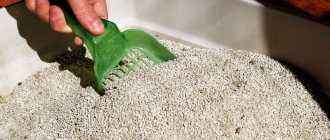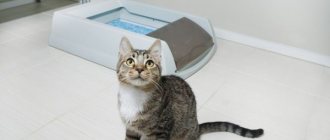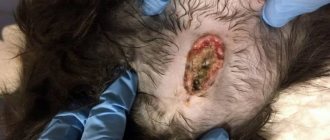As a rule, owners have a lot of worries and worries if something is wrong with their pet. Being attentive and responsible, they will immediately try to find the reasons for unpleasant changes in the health of their beloved cat. Fortunately, most pet owners constantly take care of their pets, and detect problems in the early stages, when it is possible to completely stop the developing disease. At the same time, owners often panic in vain. But if you don’t contact a veterinarian in a timely manner when, for example, a kitten has bloody diarrhea, it is unknown what this could mean for the animal.
Causes of pathology
When cleaning up the pet's potty, the owner may discover that there are several drops of blood on the feces, or that the entire mass of feces is colored reddish. Let us note right away that this is not normal, and such a signal indicates that the animal needs increased observation and attention from humans.
If blood was detected in the stool of a furry pet once, the symptom did not recur again, and the general condition of the animal is assessed as good (that is, the pet is cheerful, cheerful, eats, actively responds to affection), there is no need to worry. Most likely, there was a one-time injury to the animal’s rectum (for example, the mucous membrane could have been scratched by a sharp piece of undigested food or a small foreign object that came out naturally).
If blood appears in the stool again and again, you need to find out the reason for its appearance immediately. In a situation where bloody spots in the animal’s feces are accompanied by such manifestations as lethargy or lethargy of the pet, diarrhea or constipation, refusal to eat, increased or decreased body temperature (the norm for an adult cat is within 38-39 degrees), you need to take the pet to the clinic immediately.
The determining factors due to which a cat goes “out of need” with blood for some time are mainly the following:
- intussusception;
- gastroenteritis;
- stomach ulcer;
- helminthic infestation;
- dysbiosis accompanied by constipation;
- vascular diseases;
- bacterial infection;
- injury to the anus or intestines;
- allergic reactions;
- blood clotting failure;
- foreign objects;
- severe intoxication (when chemicals enter the body);
- benign and malignant tumors.
Blood in your cat's stool is most often caused by irritation in the lower intestine. In addition to the symptoms of hematochezia, allergies and food intolerance can be caused in pets by ordinary food, most often dry food from a dubious manufacturer.
If your cat spends most of its life in the yard or on the street, then it may have been poisoned by rat poison, then bloody stools are a common occurrence. Also, if you notice very hard and extremely dry stools in your cat, then these are clear signs that the animal has nutritional problems.
Among other things, parasites, E. coli, bacteria, worms and other agents carrying viruses of various etiologies can also cause diseases accompanied by bloody feces. Therefore, always, as a caring owner, make sure that your beloved cat does not eat just anything, anywhere, but eats normally and drinks plenty of fluids.
Natural Home Remedies
If blood is found in your kitten's stool one day and he is still eating and playing as usual, you shouldn't worry so much. Perhaps the root cause is a slight gastrointestinal upset due to overeating or eating someone else's food. Moreover, some cats' digestive systems are easily irritated by stress or sudden environmental changes. These include introducing a new pet into the home, giving birth, and changing your daily diet. Cats often need time to adapt to new brands of food to avoid acute complications.
In this case, try to keep the kitten away from food for at least 24 hours, but it is okay to give him fresh water. This way, his body will only be able to cope with the culprits in the digestive system, instead of taking in new foods. After this, your cat should be fed boiled rice, skinless chicken and plain yogurt to soothe the digestive system. It is also recommended to use a natural diet without additives or preservatives to keep your cat in shape.
You also want your cat to feel at ease. The more stressed a cat is, the more likely she is to develop colitis. Try to minimize changes to his daily routine, such as moving house or any new members moving in.
When to take your pet to the doctor
You should contact a veterinarian with your cat in the following cases:
- This is not the first time that scarlet blood has appeared in the cat’s stool, and its amount is clearly more than a drop;
- the cat meows or howls when defecating;
- during the process of defecation, the animal is clearly tense; it is impossible to poop without pushing;
- The pet often goes to the toilet to poop (normally – 1-2 times a day).
These manifestations are often accompanied by additional symptoms:
- decreased appetite;
- diarrhea with vomiting;
- increased frequency of urination;
- lethargy, apathetic mood of the pet;
- pronounced thirst;
- sudden weight loss;
- the cat runs its butt on the carpets (a sign of problems with the anal sinuses).
With these signs, you also need to observe how many times a day the cat walks around, how often there is blood and how much of it, whether there are other foreign impurities (mucus, remains of fur or undigested food, etc.). You also need to pay attention to the cat’s behavior and mood, how he eats, how much he drinks, whether there is vomiting and fever. You will need to tell the veterinarian about all this when your pet comes in for an appointment. This will help speed up diagnosis and initiation of treatment.
It is not at all necessary (and even impossible) that all of these symptoms will appear simultaneously. The manifestation of at least one of them, together with the blood that appears in the tray, is enough to show the pet to a qualified veterinarian. It is worth remembering that bleeding from the anus can cause the death of a cat quite quickly!
Collecting urine for analysis
If the owner notices bloody urine in a cat, the first thing he should do is take a urine test to diagnose the disease.
A simple option for collecting material for analysis:
- The tray is cleared of filler.
- Cleans well with boiled water (do not use chemicals!).
- Then you just have to wait for the pet to go to the toilet.
However, most pets will only go to the litter box if there is litter in it. In this case, it will not be possible to collect the liquid. Therefore, owners will have to resort to small tricks.
- You can try to watch the animal and, as soon as it settles into the tray, place a clean saucer or small bowl under it. The collected liquid is poured into a clean container and taken to the laboratory.
- You can buy a special kit at a pet store: it consists of pellets for the potty and a container for urine. This filler does not have an absorbent effect.
- You can use small aquarium pebbles as soil for the tray, preferably unpainted. You can find glass cabochons on sale that are also suitable. After the cat has done its business, the urine is collected with a sterile syringe, poured into a container and taken to the laboratory.
In severe cases, with complete obstruction of the urethra, the cat should be immediately taken to the veterinarian. He will insert a catheter, drain any accumulated urine, and collect it for analysis.
The material must be delivered for research immediately, as it quickly loses its freshness. This must be done within 4 hours.
Urine with blood
What to do before visiting a doctor
If the animal's condition and behavior are satisfactory, and there are no accompanying symptoms or they do not cause concern (for example, one-time diarrhea or constipation against the background of general health), the cat owner can take some actions before going to the veterinary hospital.
These measures include:
- Treating the animal against intestinal parasites (deworming). To do this, you need to purchase a specialized drug with an extended spectrum of action from a pet store and give it to the animal according to the instructions. If dead parasites appear in the cat’s feces within 24 hours, deworming is carried out again after ten days, monitoring the pet’s condition.
- Normalization of diet. The cat needs to be switched to a balanced diet; the easiest way to do this is to opt for ready-made dry food of the “holistic” class. They will provide the animal with all the necessary substances and elements; in addition, such food is hypoallergenic and safe.
- For long-haired cats – cleansing the intestines of hairballs. To help your pet get rid of them, it is enough to purchase a special paste. You can consult with the seller at the pet store. The paste is given to the animal according to the instructions, usually on an empty stomach (a couple of hours before feeding) twice a week.
Prevention
To protect your beloved pet from such ailments, you need to feed him a variety of foods high in protein. Choose premium food or cook natural ones. Monitor activity and prevent falls from heights. Do not transport in uncomfortable conditions, do not let him go for a walk unattended.
Happy pet
Cats that have reached the age of more than 10 years must be taken to a veterinary clinic for examination. Get tested to prevent the disease in the early stages.
Sterilized or neutered pets need special medicinal nutrition. Especially if you have a tendency to such diseases. The doctor will determine which food to give after appropriate tests.
A dangerous phenomenon is blood in the urine of animals. But it will not bring danger if you visit a doctor in a timely manner for preventive purposes and at the first signs. It is imperative to follow preventive measures.
Take care of your cats, do not expose them to unnecessary danger and stress. They will definitely surprise you more than once and give you positive emotions!
Treatment of a cat if blood is detected in the stool
The therapeutic plan is drawn up taking into account the cause of the disease. Treatment in a veterinary clinic is required only for animals in serious condition. In most cases, a cat needs to be treated with medications, and the owner needs to ensure that the pet not only takes medications in a timely manner, but also has high-quality nutrition during this period.
Important! If malfunctions of the pancreas or liver are detected, the cat is recommended to follow a diet and take medications with enzymes, for example, Pancreatin.
Diagnostics
To diagnose urocystitis and urolithiasis you will need:
- General urine analysis;
- Ultrasound of the bladder;
- BAC urine culture (not always);
- X-ray of the abdominal cavity (if urolithiasis is suspected).
For kidney inflammation:
- General urine analysis and protein/creatinine ratio in urine;
- Blood biochemistry;
- Ultrasound of the urinary system;
- BAK urine culture (not always).
For injuries:
- Ultrasound of the abdominal cavity;
- X-ray of the abdominal cavity;
- Clinical blood test.
For prostate diseases and orchitis:
- General urine analysis;
- Ultrasound of the genitourinary system;
- BAK urine culture (not always).
For diseases of the reproductive system in females:
- Ultrasound of the genitourinary system;
- General urine analysis.
For balanoposthitis:
- General urine analysis;
- Deep smear cytology;
- Ultrasound of the genitourinary system;
- TANK culture (not always).
Preventive actions
To keep your pet healthy, you need to take care of it by following simple measures to prevent possible diseases. You can prevent the occurrence of pathological conditions in which blood appears in your cat’s feces by taking into account the following animal care tips:
- keep medicines, chemicals and toxic substances out of reach;
- when choosing ready-made dry food, take into account the age, weight and health status of the pet;
- when feeding dry granules, provide the cat with free access to water and change it in a timely manner;
- carry out timely treatment of your pet against parasites;
- Take your cat to the veterinarian regularly for preventive examinations.
If you notice bloody stools, treat your cat promptly to prevent the appearance of a malignant tumor, intestinal cancer and blood clotting disorders - one of the most common diseases in most purebred cats.











